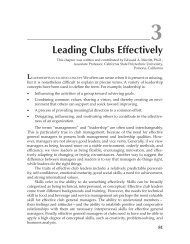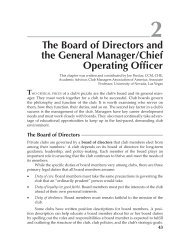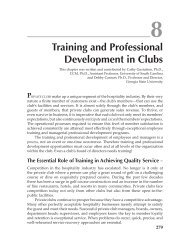Leading the Strategic Planning Process - Club Managers ...
Leading the Strategic Planning Process - Club Managers ...
Leading the Strategic Planning Process - Club Managers ...
- No tags were found...
Create successful ePaper yourself
Turn your PDF publications into a flip-book with our unique Google optimized e-Paper software.
<strong>Leading</strong> <strong>the</strong> <strong>Strategic</strong> <strong>Planning</strong> <strong>Process</strong> 1272. Mid-term operational goal: An operational goal that can be accomplished withinsix to 12 months is a mid-term goal. For example, a club’s golf course maintenancedepartment might decide in January to rebuild <strong>the</strong> bunker drainagesystem before <strong>the</strong> end of June.3. Long-term operational goal: A goal that requires 12 months or more to be accomplishedis a long-term goal. The aquatic department may be rebuilding <strong>the</strong>club’s swim team and, in late July, might set a goal of winning <strong>the</strong> club noviceleague championships held in August of <strong>the</strong> following summer.Unlike operational goals, strategic goals are usually bigger in scope and typicallyhave more uncertain or open-ended timeframes:1. Short-term strategic goal: In January a club sets a goal to admit a net total of tennew members before <strong>the</strong> end of December.2. Mid-term strategic goal: A club decides in January of 20X1 that it wants to admita net total of 30 new members before <strong>the</strong> end of December 20X4.3. Long-term strategic goal: A club decides that in <strong>the</strong> next five years it would liketo admit a net total of 50 new members. Whenever <strong>the</strong> club achieves this goal,it will become a replacement club instead of a growth club.ObjectivesObjectives are often described as <strong>the</strong> specific “whats” of a club. Objectives includeshort-term, departmental aspirations and aims. Objectives should be quantifiable—measurableby counting and timing—and should serve as steps towardgoal-achievement.As with operational and strategic goals, <strong>the</strong> distinction between operationaland strategic objectives is sometimes a fine one. For example, one could argue that<strong>the</strong> short- and mid-term strategic goals used in <strong>the</strong> examples above are actuallyinterim objectives of <strong>the</strong> long-term goal to increase <strong>the</strong> club’s net total membershipby 50 members within five years.As you proceed through <strong>the</strong>se initial stages of strategic planning, do not beoverly concerned about distinguishing an objective from a goal. Instead, concernyourself with aligning everything that <strong>the</strong> club thinks, says, does, and plans with<strong>the</strong> club’s vision and its highest, broadest goals. Spinning your wheels arguingabout whe<strong>the</strong>r a given proposal is a “goal” or an “objective” wastes your time onunproductive word games.Organizational Situation Analysis (SWOT)Situation analysis is a concept that has existed for many years. Situation analysishelps a club establish a sense of identity and direction—where it is currently andwhere it might go in <strong>the</strong> future. Such analysis helps evaluate a club’s strengths,weaknesses, opportunities, and threats (SWOT). SWOT analysis is a valuable toolfor planning <strong>the</strong> strategic direction of a club.
















